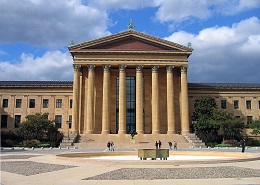

Benjamin Franklin Parkway
A Bit of Paris in Philadelphia
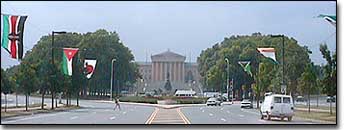

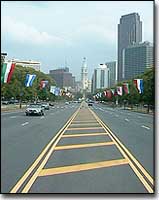
"The Prophet," a statue by Jacob Lipkin (1974), on 16th Street in a small park, one of the most judiciously landscaped spots in the city. To the right between 16th and 17th Street is the Pennwalt Building.
LOVE Park
Begin at LOVE Park (officially John F. Kennedy Plaza) on the west side of City Hall. On the corner of 16th is the circular glass Tourist Center, which is now closed to the public. This was once a skateboarding mecca, but the city clamped down and made the sport illegal here. During the milder days of the year there is often entertainment of some sort here — concerts, evangelical and gospel singers, political speeches, dancing, string bands, sporting exhibitions. Lunchtime crowds flock to see and hear these groups and senior citizens make up much of the audience for the summer-evening concerts. The fountain is a thing of beauty, but it has a lighter aspect, too. High school students regularly celebrate the end of the school year by taking off their shoes and stockings (some don't!) and cavorting in the fountain.
Henry Moore Sculpture
Fine pieces of sculpture are placed strategically, notably "Three Way Piece" by Henry Moore, near the corner of 15th and Arch Streets. Perhaps Kennedy Plaza is most beautiful at night with globes that serve as lamps in the square and the buildings around it — Penn center, City Hall, the Masonic Temple, the Arch Street Methodist Church — lighted, and in the distance the floodlighted Museum of Art. At this time, when Philadelphia becomes a City of Light, the relationship between Center City and the Parkway is even more evident as is that of Philadelphia to its Parisian model.
Friends Select School
That part nearest 16th Street houses offices. The 17th Street side is occupied by the Friends Select School (founded 1689). At one time the entire block between 16th and 17th, the Parkway and Race Street, was occupied by the school and its grounds. Just inside the door of the school stands a grandfather's clock made by John Child of Philadelphia. A brass plate on the clock tells us that the school first came into possession of it in 1839. For many years it had belonged to the Friends School at 4th and Chestnut Street and was used in regulating the clock in the tower of Independence Hall.
Statue of Copernicus
Farther along at Cherry Street, before the new United Fund Building, is the steel construction to Copernicus, the Polish astronomer. A plate at the base denotes that soil from his birthplace at Torun, Poland, is placed here. German and Polish groups had a lively battle, in and out of the press, before the monument was even in place as to whether Copernicus was a German or a Pole. The Poles evidently triumphed for his name on the marble base is spelled Kopernik.
Cathedral of SS. Peter and Paul
Opposite the monument, across Race Street, was the residence of the cardinal of the Roman Catholic Archdiocese of Philadelphia. Behind the residence, the reddish brownstone Cathedral of SS. Peter and Paul, built between 1846 and 1864, dominates the area. Napoleon Le Brun, who designed the Academy of Music, and John Notman, whose buildings include the Athenaeum and the Church of the Holy Trinity, were the architects. Its Palladian facade and copper dome are in the Italian Renaissance manner, and the interior is spacious with magnificent proportions reminiscent of Roman churches. It was largely decorated by Constantino Brumidi (1805-90), who painted the dome of the Capitol in Washington. A baldachin over the main altar and the three altars on each of the side aisles point up this Italian Renaissance flavor.
Parkway Sculptures
Just in front, in the small park opposite, is a statue of Thomas FitzSimons (1741-1811), born in Ireland and a Signer of the Constitution, a member of the Constitutional Convention and of the 1st, 2nd and 3rd Congresses. He is buried in St. Mary's burying ground, visited on the Society Hill Virtual Walking Tour.
Now follow the path along the outer edge of the drive around Logan Circle, passing the monument to Galusha Pennypacker, Brevet Major General, United States Army, and the Shakespeare Memorial, "Hamlet and the Fool" by Alexander Stirling Calder. Erected in 1928, it commemorates Philadelphia's Shakespearean scholars and such actors as Joseph Jefferson, John Drew, Louisa Lane Drew and Edwin Forrest among others.
Swann Fountain (Logan Circle)
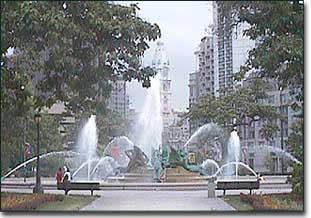
Free Library of Philadelphia
The Free Library of Philadelphia, to the right of the Shakespeare monument (its balancing building is the County Court Building behind the Pennypacker monument), is one of the great libraries of the country. The main library of the Philadelphia system, anyone may use its resources on the spot. There are always exhibits of interest in the entrance hall, concerts, lectures and films throughout the year. There is a cafeteria on the roof, and during the summer you can eat alfresco and enjoy the panorama of Philadelphia.
One of the riches of the Free Library is the Rare Book Department, which has holdings spanning 5000 years, from cuneiform tablets, European manuscripts dating from the 9th through the 18th century, examples of calligraphy, Oriental manuscripts and miniatures, incunabula, Pennsylvania German frakturs and the William McIntire Elkins library. This handsome Georgian room was removed from Mr. Elkins home in Whitemarsh, on the outskirts of Philadelphia, and installed in the library in 1949. Richly paneled, the room contains Mr. Elkins own fine library, a notable collection of Dickens' letters and editions, Dickens' desk and candleholder and even his pet raven which was stuffed in 1841! There is a Poe connection, too, for Poe had reviewed "Barnaby Rudge" and didn't feel Dickens had done justice to the raven in this portrait of it. "The Raven," more in keeping with Poe's idea of the bird, was the result. The library also has the gravestone of Dickens pet canary ("Dick the Best of Friends"), something of which no other rare book department can boast.
Raemisch Sculptures
Leaving the library, turn right, cross 20th Street and pass the Youth Study Center, with the two sculptural groups of 1955, "The Great Doctor" and "The Great Mother" by Waldemar Raemisch.
Rodin Museum
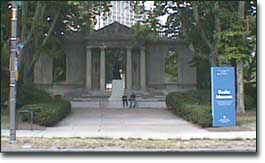
Given by Jules Mastbaum, the theatrical magnate, to the citizens of Philadelphia (he died in 1926 before it was begun), the museum contains some of Rodin's greatest figures — "The Burghers of Calais," "Adam," "Eve," "St. John the Baptist Preaching," busts and figures of Balzac, and busts of Gustav Mahler, George Bernard Shaw, Victor Hugo, Georges Clemenceau, Pope Benedict XV and Puvis de Chavannes. Sketches, drawings, books and papers of Rodin's are on deposit as well as plaster casts and a fine series of mood photographs of Rodin at Meudon by Edward Steichen. The plaster of "Eternal Springtime" is the original Rodin sculpture which the artist presented to Robert Louis Stevenson in 1885.
Eakins Circle
Now walk the remaining stretch of the Parkway to the plaza before the Philadelphia Museum of Art, which Lord Dunsany called the most beautiful building in America. The plaza, named for Thomas Eakins (1844-1916), the great Philadelphia painter who is best known for "The Gross Clinic" and "The Agnew Clinic," leads to three fountains. The center fountain, dedicated to Washington, was erected by the Society of the Cincinnati of Pennsylvania. The four figures and the animals overlooking the pools at the base represent four great waterways of America — the Mississippi, the Potomac, the Delaware and the Hudson.
Philadelphia Museum of Art
The pediment or tympanum on the north wing was done by C. Paul Jennewein and illustrates the theme of sacred and profane love. There are thirteen classical figures, the central one of Zeus signifying the creative force, with Demeter, the laurel tree, Theseus, Aphrodite and Eros to the sides. Unfortunately, funds were never available to complete it with similar groups on the central and south buildings.
Movie-lovers will remember the long set of steps in front of the museum as the spot where boxing underdog, Rocky Balboa, made his triumphant run — arriving at the top with hands raised aloft in triumph. Today, tourists reenact Rocky's run (or at least the last few steps), posing for photos at the summit of the stairs.
Inside, the Great Stair Hall is awesome in its magnitude and provides a fitting setting for the thirteen magnificent tapestries from the Palazzo Barberini in Rome (a gift of the Samuel H. Kress Foundation), "Diana" at the top of the stairs whose poised figure once graced — as a weathervane — the first Madison Square Garden in New York (Gotham, likely, would like to have it back) and "Ghost," a mobile by the present-day Alexander Calder, son of the sculptor of the Logan Circle fountain and grandson of the man who created William Penn on the top of City Hall. Because of the name of the mobile, the three sculptors have often been irreverently called "the father, son and unholy ghost."
Every museum has its most popular works and the Philadelphia Museum of Art is no exception. Through the years it has found the favorites of the public to be: "Nude Descending a Staircase" by Marcel Duchamp, Van Gogh's "Sunflowers," the large "Bathers" by Cezanne, Picasso's "Three Musicians," and Brancusi's sculptures, variations on his "Bird in Space" theme and "The Kiss." Leaving the museum, descend the steps, cross over to the fountains and take the righthand walk down the Parkway.
Franklin Institute
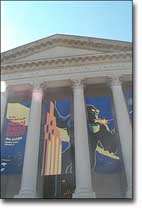
The trains and planes are part of the excitement. In all these exhibits the visitor participates. A Link Trainer in the Hall of Aviation can be used by anyone between the ages of 13 and 20, who is at least five feet tall. It is possible to clamber into a United States Air Force plane, sit behind the controls and get the feel of it. In the same vein we can climb aboard a 1926 Baldwin locomotive or an earlier American engine (1842) to the sound of train whistles and bells, although the "Rocket" — constructed in London in 1838 — is just for viewing and not for climbing into. The pilot house and the bridge of a ship in the marine museum are open in the same way, and the models of John Fitch's steamboat (1796) and Robert Fulton's Clermont (1807) are activated when a button is pushed. Fitch and Philadelphia have never gotten full credit for Fitch's having invented the steamship before Fulton.
The philosophy of the Franklin Institute, could easily be expressed in the words of Thomas Huxley inscribed around the lip of a basin which is in the museum: Sit down before a fact as a child, / be prepared to give up every preconceived notion, / follow humbly wherever nature leads, / or you will learn nothing.
St. Clement's Episcopal Church
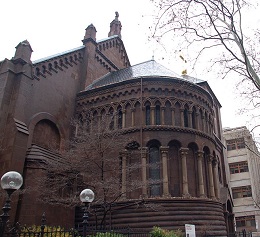
Photo by User:Dgf32
Shared via CC Attribution 3.0 Licence
Leaving Franklin Institute turn right, cross Race Street, pass the Franklin Institute Research Laboratories and at the corner of Cherry Street (actually between Cherry and Appletree) is St. Clement's Episcopal Church. The Episcopalians have some of Philadelphia's most interesting and historic churches and by and large the ones with the greatest architectural beauty, such as this John Notman one of 1859. Walk to Appletree Street, and just around the corner is the entrance to the garden and the church itself. The high altar has a fine triptych and the stained glass, even on a dull day or when the church is unlighted, is especially notable.
Academy of Natural Sciences
At the corner of 19th and Race Streets stands the Academy of Natural Sciences, the oldest institution of its kinds in America, founded in 1812. The Academy, one of Philadelphia's most active and progressive museums, houses cases of stuffed birds and animals displayed in backgrounds simulating their natural habits, fossils-including a collection of Thomas Jefferson's — models of extinct animals, insects and shells. An exhibit such as "What's inside a python?" shows the skeletal structure without the skin. A show stopping sign says: "Look." When the viewer looks into the glass the size of an eye, he is gazing into the eye of an owl! The gems, minerals, fluorescent minerals are alone worth a visit. The Academy, like the Franklin Institute, endeavors to make natural science a simple, understandable thing on an everyday level, explaining it in a way that relates to the world around us.
Leaving the Academy of Natural Sciences, cross 19th Street, walk along to 18th and then cross that street. At the Embassy Suites Hotel, there is another sculpture worthy of note. At the rear of the building, on the point of land where Cherry Street crosses the Parkway, we find the handsome sculpture-fountain by Oskar Stonorov and Jorio Vivarelli, with water cascading over a male figure holding a young girl aloft, as two others prepare to help lift her from the pool below. This is an example of the benefits of the Philadelphia one-percent-of-building-costs rule. This city regulation commits architects and builders to set aside that percentage for decoration — sculpture, a mural, bas relief — on buildings constructed within the city limits. It is responsible for some of the more exciting contemporary art seen on or in our new buildings.
Mace's Crossing
Opposite it is Mace's Crossing, a tavern which refused to leave when the apartment building behind it — The Windsor — was constructed. It provides one of those accidental but delightful accents which enliven a city. It is also a rather old-fashioned watering spot, rather than a cocktail lounge like those in the fashionable buildings nearby.
Sculpture to the martyrs
Walk along to the corner of 16th and Arch Street, with the Pennnwalt Building and friends Select School on the left. Here is the monument by C. Natan Rapoport (1964) in memory of the six million jewish martyrs who perished at the hands of the Nazis between 1933 and 1945. It is a powerful statement of struggle and agony. Among the striving figures can be discerned the torah, an old scholar wearing his prayer shawl and an arm holding a sword for freedom.
Thaddeus Kosciuszko
In the Logan Square area a new look had come to Philadelphia. Facing the Parkway, between 18th and 19th Streets and just opposite the academy of Natural Sciences, is the Four Seasons Hotel, which opened in 1983. In front, an heroic statue of Thaddeus Kosciuszko by Marian Konieczny glorifies the Polish military genius. The white and red base of the monument symbolizes the colors of the polish flag. It was given to the United States by the Polish people as sign of Polish-American friendship and to commemorate 200 years of our independence.
Learn More: Benjamin Franklin Parkway Walking Tour

